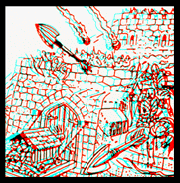
The use of polychromatic anaglyph is problematic enough when used in conjunction with stereophotography. But hand-drawn multicolor line anaglyphs present even greater challenges. In 1990 and 1991 two 3-D artists who had been producing anaglyph images by hand for years published works which addressed the polychromatic anaglyph.

British artist Arthur N. Girling had been creating stereoscopic drawing, much of it in anaglyph, for over forty years. In 1990 he self-published the result of his life work in this unique medium with Stereoscopic Drawing, A Theory of 3-D Vision and Its Application to Stereoscopic Drawing. This publication features a section of 2-color anaglyph images which demonstrate the Girling expertise in 3-D drawing and conversion. In a separate appendix Girling discusses the kind of imagery best suited for colour anaglyph:
Although essentially a black and white system, a certain amount of colour can be introduced into the anaglyph. Colours other than red, blue and green pass through both filters and successfully combine in the 3-D image, e.g., white, yellow, brown, gold, bronze, silver. Full red, green and blue create deep shadows through rejection by their opposite viewing filters and should not be used. The rejection of pale red, blue and green gives rise to light shadows and results in degraded colours; pale red becomes a rust colour, pale green becomes olive green and pale blue becomes lilac or purple. Examination of successful coloured anaglyph photographs shows a selective use of colours.
Laszlo P. Futo, a Swiss professor of descriptive geometry, author and artist, has instituted the art of anaglyph painting. In his 1991 book of the same title he offers a survey of his work in this groundbreaking medium. Futo produced his first anaglyph painting in 1973 and subsequently began to teach the technique. In 1986, Futo opened his own art gallery in Zurich-Hongg where this rare art form has been on view many times.
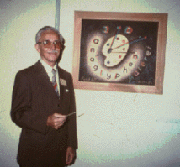
With his anaglyph painting, Futo has many times used an extended palette of colors that go beyond the complementary colors used with the 2-color form. In many of his abstract compositions, such as those from 1974 and a watercolour work titled Autumn from 1977 he has incorporated additional color. Other unique applications of the anaglyph that Futo has inaugurated include a color anaglyph tapestry and a series of interesting 2-color anaglyphs that use only red and black in combination.
The 3-D Video patent for a stereoscopic television system authored by James Butterfield, Stanton Alger and Dan Symmes and dated March 29, 1988 includes a theoretical discussion of full color anaglyph. A schematic diagram (Fig. 11A) is also enclosed which illustrates the optical mechanism of the anaglyph glasses for viewing the full (three) color anaglyph picture. Five points of illumination are shown in the drawing for black (X), red, green, blue and white (W) and the illumination of the two images is 100% additive mentally. The viewer perceives a color anaglyph picture (8) as a full color, well-balanced stereoscopic picture.
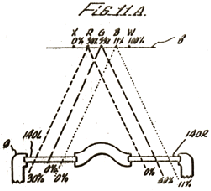
However, in actual practice, states the patent, the brain has some difficulty in fusing and combining stereopairs of images in which a primary color appears in a large area of one image and a corresponding black area appears in the other image. This phenomenon of complementary color bombardment to either eye has been called retinal rivalry by some practicing stereographers.
The profusion of image editing software such as Adobe Photoshop and Corel Paint in the 1990s along with the explosion of desktop publishing has made it possible for many photographers and artists to produce their own polychromatic anaglyphs. Anaglyph imagery has a widescale presence on the World Wide Internet and much of it is full color in nature.
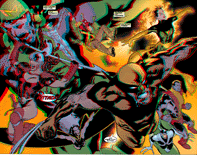
Using Adobe Photoshop as a tool, the 3-D Zone produced a series of 3-D comic books for Image Publishing in 1997 and 1998 that were entirely in color and 3-D, a landmark in the medium. With digital manipulation of a 4-color matrix, and portability between additive and subtractive filtration schemes, the production of full color 3-D comics is now a viable reality. Photographic imagery, as well as line art, lends itself to polychromatic anaglyph applications with the new digital tools. In particular, the inherent limitations of color 3-D, as are enumerated in the 3-D Video patent, can be effectively addressed for production of stereographic images that have rich color rendition as well as a high degree of 3-D impact.
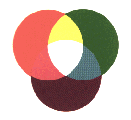
Dudley, Leslie P. Stereoptics, An Introduction. London: MacDonald & Co. 1951.
Futo, L.P. Anaglyph Painting. Zurich: Phanomen-Art Verlag Zurich. 1991.
Girling, Arthur N. Stereoscopic Drawing: A Theory of 3-D Vision and Its Application to Stereoscopic Drawing. London: Arthur Girling. 1990.
Helmholtz, H. von. 1925. Treatise on Physiological Optics. Vol. III 3rd Ed. Optical Society of America. Menasha, Wisconsin. 281-709.
Jones, Bernard E. How to Make and Operate Moving Pictures. New York and London: Funk & Wagnalls Company. 1917.
Judge, Arthur W. Stereoscopic Photography, Its Application to Science, Industry and Education. Boston: American Photographic Publishing Co. 1926.
Linssen, E.F. Stereo-Photography in Practice. London: The Fountain Press. 1952.
Lipton, Lenny. Foundations of the Stereoscopic Cinema, A Study in Depth. New York: Van Nostrand Reinhold. 1982.
Morgan, Hal and Symmes, Dan. Amazing 3-D. Boston: Little, Brown & Co. 1982.
Sipley, Louis Walton. A Half Century of Color. New York: Macmillan Company. 1951.
